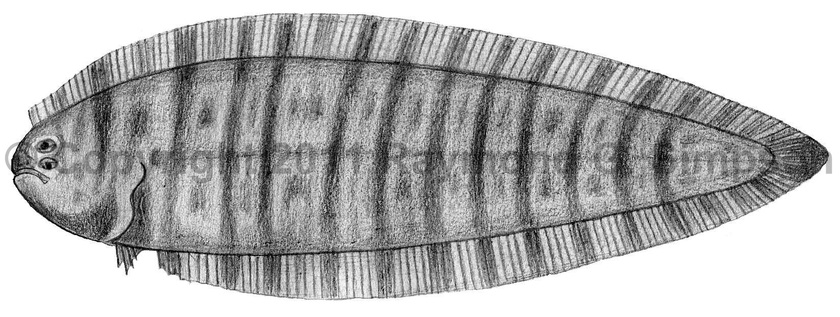
Common Name
Caribbean Smalleyed Tonguefish
Year Described
Munroe, 1991
Identification
Dorsal Fin Rays: 97-106
Anal Fin Rays: 81-89
Pectoral Fin Rays: none
Pelvic Fin Rays: 4
Caudal Fin Rays: 12
Longitudinal Scale Rows: 84-97
Vertebrae: 52-55
Pterygiophore pattern (1st three interneural spaces): 1-4-3
Other diagnostic characters include: pupillary operculum absent, ocular side premaxillary either toothless or scaled only on the anterior 1/3 of margin, ocular side lower jaw with distinct fleshy ridge, and scales absent from the distal 2/3 of blind side dorsal and anal fins.
Color
Varying shades of brown with 10-14 dark contrasting crossbands that continue onto dorsal and anal fins. Outer opercle on ocular side darkly pigmented with melanophores. Inner opercle also darkly pigmented. Peritoneum unpigmented. Dorsal, anal, and caudal fins with alternating dark and light blotches, becoming darker and less distinct posteriorly. Blind side pale.
Size
Mature adults from 110-160mm. Maximum size 190mm.
Habitat
Continental shalf from 7-110m (usually 11-70m), over muddy bottoms.
Range Map

Range
Guyana to NE Brazil
References
Munroe, T.A. 1998. Systematics and ecology of western Atlantic tonguefishes (Symphurus: Cynoglossidae: Pleuronectiformes). Fish. Bull. 96(1):1-182.
Munroe, T. A. 2003. Bothidae (Pp. 1885-1895), Scophthalmidae (Pp. 1896-1897), Paralichthyidae (Pp. 1898-1921), Poecilopsettidae (Pp. 1922-1923), Achiridae (Pp. 1925-1933), Cynoglossidae (Pp. 1934-1959). In: Carpenter. 2003. The living marine resources of the Western Central Atlantic v. 3.